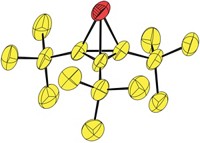Advertisement
Grab your lab coat. Let's get started
Welcome!
Welcome!
Create an account below to get 6 C&EN articles per month, receive newsletters and more - all free.
It seems this is your first time logging in online. Please enter the following information to continue.
As an ACS member you automatically get access to this site. All we need is few more details to create your reading experience.
Not you? Sign in with a different account.
Not you? Sign in with a different account.
ERROR 1
ERROR 1
ERROR 2
ERROR 2
ERROR 2
ERROR 2
ERROR 2
Password and Confirm password must match.
If you have an ACS member number, please enter it here so we can link this account to your membership. (optional)
ERROR 2
ACS values your privacy. By submitting your information, you are gaining access to C&EN and subscribing to our weekly newsletter. We use the information you provide to make your reading experience better, and we will never sell your data to third party members.
Materials
Corannulene Scale-Up
Optimized synthetic approach could lead to commercial availability
by Stu Borman
March 5, 2012
| A version of this story appeared in
Volume 90, Issue 10
A new synthesis of the hexacyclic organic compound corannulene that boosts its availability by two orders of magnitude could lead to its commercialization for a range of potential applications.
With 20 carbon atoms, corannulene is one-third the size of C60 and the smallest subunit that maintains C60’s curvaceous shape. It’s of interest as a potential component of polymers, electro-optical materials, fluorescent dyes, and other advanced materials.
Until now, availability of corannulene has been limited. Gram to tens-of-gram syntheses of corannulene and its derivatives were developed independently in the 1990s by three groups led by Jay S. Siegel of the University of Zurich, Lawrence T. Scott of Boston College, and Andrzej Sygula and Peter W. Rabideau of Mississippi State University. But the procedures were wasteful and expensive, used hazardous solvents and harsh reagents, and couldn’t be scaled up in a practical manner.
Siegel, grad student Anna M. Butterfield, and technician Bruno Gilomen now report an optimized route to corannulene (Org. Process Res. Dev., DOI: 10.1021/op200387s). Starting with existing gram-level syntheses, they eliminated all four of the column chromatography separation steps they required, substituted safer and less costly solvents, and minimized solvent use. The result was 1.3 kg of corannulene in 8.7% yield from a simple chloroxylene starting material.
The researchers note that the search for a better synthesis is not over. They believe the efficiency of their procedure could still be improved 100-fold.
Sygula comments that “the kilogram-scale preparation work marks another step on the road to efficient syntheses of novel aromatic compounds. The major achievement of the reported study is a possibility of commercialization of corannulene. There may be some demand from materials scientists not able to synthesize it.”
“Given the history of the synthesis of corannulene for many years in very low yield,” Rabideau says, “the production of 1.3 kg of this novel ‘buckybowl’ is incredible. Most organic syntheses described in the literature are not crafted with scale-up in mind, and that makes this work especially interesting.”
Scott says he believes the study “will revolutionize the way chemists think about this truly unique compound. Corannulene is not yet commercially available, but this work is likely to change that.”
He notes that corannulene shares with C60 the ability to accept electrons readily, enabling it to be reversibly reduced to a tetra-anion that is stable in an oxygen-free environment. C60’s ability to take on as many as six electrons has stimulated dreams of using it in lightweight organic batteries, solar cells, and organic electronic devices, he says. Corannulene has twice the electron-carrying capacity because its 20 carbons take on four electrons, whereas C60’s 60 carbons take on only six. That makes corannulene a more promising candidate material for such applications, Scott says.
Corannulene could also be functionalized chemically in a variety of ways to create potentially useful derivatives. “Decorating the corannulene core in different ways will yield an endless collection of compounds with diverse molecular electronic and photophysical properties,” Scott says.
According to Siegel, 30 research groups have already requested corannulene samples, and two companies have expressed interest in offering corannulene commercially. The chemistry community “is willing and ready to play creatively with corannulene,” he says. “The knowledge that corannulene is available in kilogram amounts will set off a wave of creative investigation.” With this incentive, he adds, “process chemists far more clever than me will look into ways to make corannulene cheaper and on an even larger scale.”






Join the conversation
Contact the reporter
Submit a Letter to the Editor for publication
Engage with us on Twitter